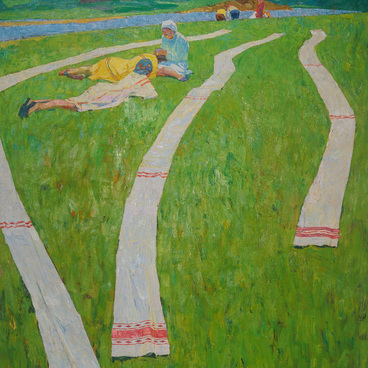The horse pendant is a find from the Shokshynsky burial ground. The product is a rectangular shield with a pattern imitating filigree, turning in the upper part into a paired image of horse heads, on the neck of which is a ring with a triangular pendant. The lower part of the shield is decorated with five cast rings, with chains and pendants in the form of the feet of a waterfowl.
The Shokshynsky burial ground is an archaeological monument of the Ryazan-Oka tribes. The burial site dates from the second half of the 5th century to the early 11th century and is located near the village of Kulikovo in the Tengushevsky district of the Republic of Mordovia. The archaeologists Alexey Tsirkin and Viktor Shitov studied more than a thousand burials there. In men’s graves they found tools (socketed and eye axes, sickles, knives, adzes, scrapers), weapons (swords, sabers, daggers, spear and arrow heads, battle axes), fragments of protective armor, reins and stirrups. Women’s burials contained silver and bronze ornaments: headbands, temple rings, torcs, necklaces made of beads and pendants, breastplates, and bracelets.
The exhibition of the museum displays jewelry from the Shokshynsky burial ground. Their patterns feature zoomorphic motifs: realistically depicted in the early centuries, the figures evolved in the later period to decoratively conventional and stylized images. Most of them are horse pendants with rattling duck foot or bottle-shaped pendants. The exhibition presents unique samples of chest clasps in the form of solar signs, topped with horse heads, diverse variants of cast horse pendants with openwork shields, imitating filigree with granulation. In addition, oriental silver coins, belt sets, a sword with the stamp of Western armories and a ring with an Arabic inscription were found in the Shokshynsky burial ground, which attests to the contacts of the local population with other peoples.
The find from the Shokshynsky burial ground testifies to the development of zoomorphic motifs in the jewelry art of the ancient Mordovians. The filigree and granulation technique required the artist to be highly skilled. In this case it is an imitation of these techniques.
The artifact shows that the ancient jewelers knew the methods that allowed them to imitate the most complicated techniques and create works of high artistic merit. The pendant is made in the technique of casting from a wax model.
The Shokshynsky burial ground is an archaeological monument of the Ryazan-Oka tribes. The burial site dates from the second half of the 5th century to the early 11th century and is located near the village of Kulikovo in the Tengushevsky district of the Republic of Mordovia. The archaeologists Alexey Tsirkin and Viktor Shitov studied more than a thousand burials there. In men’s graves they found tools (socketed and eye axes, sickles, knives, adzes, scrapers), weapons (swords, sabers, daggers, spear and arrow heads, battle axes), fragments of protective armor, reins and stirrups. Women’s burials contained silver and bronze ornaments: headbands, temple rings, torcs, necklaces made of beads and pendants, breastplates, and bracelets.
The exhibition of the museum displays jewelry from the Shokshynsky burial ground. Their patterns feature zoomorphic motifs: realistically depicted in the early centuries, the figures evolved in the later period to decoratively conventional and stylized images. Most of them are horse pendants with rattling duck foot or bottle-shaped pendants. The exhibition presents unique samples of chest clasps in the form of solar signs, topped with horse heads, diverse variants of cast horse pendants with openwork shields, imitating filigree with granulation. In addition, oriental silver coins, belt sets, a sword with the stamp of Western armories and a ring with an Arabic inscription were found in the Shokshynsky burial ground, which attests to the contacts of the local population with other peoples.
The find from the Shokshynsky burial ground testifies to the development of zoomorphic motifs in the jewelry art of the ancient Mordovians. The filigree and granulation technique required the artist to be highly skilled. In this case it is an imitation of these techniques.
The artifact shows that the ancient jewelers knew the methods that allowed them to imitate the most complicated techniques and create works of high artistic merit. The pendant is made in the technique of casting from a wax model.



